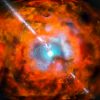Twinkle, Twinkle Little...Magnet?
For nearly 50 years, scientists have been studying two distinct types of stars: Pulsars and magnetars. As far as anyone knew, they were right — these two types of stars had very different behaviors, though there has been some evidence that perhaps they were linked. A new transition state may prove further connections between these two types of stars.
Radio Pulsars vs. Magnetars
First, let’s explore the difference between radio pulsars and magnetars. While both stars are neutron stars created from the remnants of exploded stars, they behave very different. Radio pulsars send out radio waves predictably due to their fast rotation. Magnetars, however, are more unpredictable and send out gamma waves and X-rays irregularly. They also have the strongest magnetic fields we know of. Because they behave so differently, it’s been speculated that they are two different entities. One rogue star, however, is poised to change this theory.
J1119: The Missing Link
A radio pulsar star, PSR J1119-6127, has been observed for the past 16 years, and had behaved perfectly predictably until recently. Made from remains of a dense star that had exploded, J1119 would send out radio waves very predictably. This is the hallmark of a radio pulsar star, and so was what scientists were looking for. However, in July 2016, space observatories noticed that J1119 was emitting unpredictable X-ray bursts and other energy — the hallmark of a magnetar.
10 days later, the event was over and J1119 was behaving normally again. Scientists believe that they were observing a state that links together two formerly disparate types of objects. Though a study was recently published outlining the event, scientists are still in disagreement over which comes first: The pulsar or the magnetar. Read more about the debate on Phys.org.
Magnetic space phenomena aren’t new — we’ve talked about them quite a bit in the past, covering topics like the Milky Way and the Van Allen radiation belts. However, this is quite an unusual phenomenon: A space object changing from one type of established object to another. Learn more about magnets in space on our blog.

